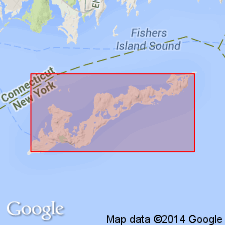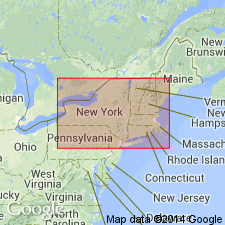
- Usage in publication:
-
- Gardiner clay
- Modifications:
-
- Named
- Dominant lithology:
-
- Clay
- AAPG geologic province:
-
- Atlantic Coast basin
Summary:
Name Gardiner clay applied to interglacial deposit, 30 to 150 ft thick on Fishers Island, NY, conformably overlying the glacial Jameco gravel. Conformably underlies the interglacial Jacob sand Correlated with early part of Yarmouth stage of Mississippi Valley.
Source: GNU records (USGS DDS-6; Reston GNULEX).

- Usage in publication:
-
- Gardiners Clay
- Modifications:
-
- Revised
- AAPG geologic province:
-
- Atlantic Coast basin
Summary:
Gardiners Clay is here restricted to marine clay containing fossil assemblages that indicate sea-water temperatures somewhat warmer to somewhat cooler than present sea-water temperatures off Long Island. Unit lacks radiometric ages, but Stone and Borns (1986) reported AAR age estimates of 80 to 130 ka. Belknap (1980) reported AAR age estimates that indicated both isotope stage 5 and isotope stage 7 to 9 ages for the shells in the Gardiners clay. Age then is inferred to be Sangamonian. Stratigraphically underlies the Montauk Till Member of the Manhasset Formation, which is everywhere faulted and folded making it difficult to establish its stratigraphic position relative to under and overlying deposits. The Montauk is here interpreted to be Illinoian.
Source: GNU records (USGS DDS-6; Reston GNULEX).
For more information, please contact Nancy Stamm, Geologic Names Committee Secretary.
Asterisk (*) indicates published by U.S. Geological Survey authors.
"No current usage" (†) implies that a name has been abandoned or has fallen into disuse. Former usage and, if known, replacement name given in parentheses ( ).
Slash (/) indicates name conflicts with nomenclatural guidelines (CSN, 1933; ACSN, 1961, 1970; NACSN, 1983, 2005, 2021). May be explained within brackets ([ ]).

